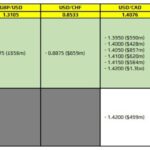
10-Year Treasury Yields Fall Below 4%: A Game Changer for Investors
Tháng 4 4, 2025
Mastering FX Option Expiries: Essential Trends and Strategies for April 2025
Tháng 4 4, 2025European Central Bank’s Prospects for Rate Cuts Amid Economic Pressures
In light of current international economic conditions and geopolitical developments, recent reports indicate that the European Central Bank (ECB) is seriously considering implementing rate cuts this month. Such a move is anticipated in response to ongoing pressures from both the domestic and global economic landscapes.
Rate Cut Expectations and Economic Context
Prominent financial institution Nomura has recently adjusted its outlook for the ECB, predicting a possible rate cut as early as this April. This forecast aligns closely with market expectations that have been considerably influenced by erratic global economic conditions, primarily stemming from the recent announcement of new tariffs by the U.S. government. These tariffs, introduced under the Trump administration, have raised significant concerns about potential slower growth across various sectors, which, in turn, amplifies the pressure on the ECB to act swiftly. Traders and investors are keenly observing these developments as they potentially signal a shift in fiscal policy that could aim to stabilize the economic environment in the Eurozone. For further insights on the implications of global trade policies, including tariffs, on international markets, you can read more here.
The Impact of US Tariffs on European Economies
The introduction of new tariffs by the U.S. has markedly changed the landscape for European markets, causing an immediate reaction reflected in the decline of European shares. Analysts argue that such tariffs could stifle growth, leading to increased fears surrounding the economic stability of the Eurozone. The heightened expectations for ECB intervention—particularly in the form of rate cuts—are increasingly seen as essential to mitigating these adverse effects. By lowering interest rates, the ECB could provide much-needed support to consumers and businesses, thereby fostering a more favorable economic climate amidst the uncertainty generated by foreign trade policies.
Inflation Trends and Economic Data Signaling
Another significant factor contributing to the expectation of rate cuts is the trajectory of inflation within the Eurozone. Recent economic data has indicated softer inflation rates, which may bolster the argument for an adjustment in the ECB’s monetary policy. Lower inflation diminishes the urgency for high interest rates to combat price increases, thus allowing the ECB more flexibility to pursue a path of monetary easing. This dynamic presents a compelling case for moving toward a more accommodative monetary stance to stimulate growth.
Market Participants Await ECB Decisions
As the anticipation for the ECB’s upcoming decision grows, Eurozone bond yields have taken a downward turn, signaling cautious investor sentiment. This decline reflects the heightened uncertainty pervading the markets, as investors position themselves for potential bouts of monetary easing. The converging influences of external tariffs and local economic indicators create a complex tapestry of motivations prompting the ECB to take decisive action. Market participants are closely monitoring these developments, aware that the ECB’s decisions could significantly influence not just the Eurozone economy, but the broader global financial landscape as well. A recent analysis on the EUR/USD currency pair highlights important market dynamics that are relevant in understanding these economic circumstances, which you can explore here.
In conclusion, the upcoming ECB meeting promises to be pivotal. With rate cut expectations mounting driven by global economic uncertainties and recent inflation trends, the ECB is positioned at a crossroads, balancing the need for economic stimulus against the complexities of international trade dynamics. As insights unfold, stakeholders will remain watchful for how these factors may dictate future monetary policies.

